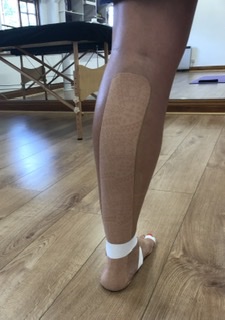I often see running injuries in my physio clinic. One of the most common complaints is heel pain when running. I also see a lot of clients suffering with this condition who don’t run. Running isn’t the only reason why you could be suffering with plantar heel pain.
What is Plantar Heel Pain?
Previously know as Plantar Fasciitis, this condition is a pain in the bottom of the foot which is usually felt around the heel. You feel pain in this area because the connective tissue that runs along the bottom of the foot (called the plantar fascia) becomes irritated. The role of the plantar fascia is to support the arch of your foot and act as a shock absorber to the bottom of the foot.
What are the symptoms of plantar heel pain?
It usually feels worse:
- When you first start walking / weight bearing after sleeping or being sat down for a prolonged period of time
- If you push up onto your toes
- After spending a long time on your feet, such as going for a walk or run
What causes heel pain when running?
Like most aches and pains, the cause can be due to just one factor, but is much more likely to be a combination of a few things. These include:
- Increased time on feet
- Footwear which does not give you the support you need
- Increased weight / BMI
- Too quick an increase in weight bearing exercise / running
- Weakness & tightness of the posterior chain (calf, hamstrings & gluteal muscles)
Which treatments are available for heel pain when running, and which work the best?
I’ve added a reel to my Instagram page showing you a few simple ways to manage this injury yourself at home. You can take a look by clicking here.
Physiotherapy treatments commonly used that can give some alleviation of symptoms include:
- A loading / strengthening programme
- Rolling / massage to the bottom of the foot & posterior chain
- Stretches
- Shockwave therapy – whilst I don’t provide this at Animated Physio, I recommend another local clinic, Finely Tuned Physio, if you are looking to go down this treatment route
- Taping
- Ice
- Orthotics / supportive footwear
- Advice on resting and modification of aggravating activities

These can all help with symptom reduction, but this is often short-term as they do not address source of problem.
Recent research showed a specific exercise programme can be very helpful when the protocol is followed correctly. The protocol involves completing sets of loaded heel raises off a step, with a rolled up towel under your toes. This raises the toes of the affected foot, and so puts extra length and work through the plantar fascia when completing the exercise.
What’s the best exercise to try to ease heel pain when running?
The exercise should be completed very slowly, in a controlled manner. You should take 3 seconds to raise up onto your toes, hold for 2 seconds at the top, then take 3 seconds to lower down. This means one repetition takes a total of 8 seconds.



You should start at 3 sets of 12 repetitions at body weight, and gradually add weight over the next few weeks as able. This can be done by wearing a backpack and adding weights or bottles of water / tins of beans to it. As the weeks go by, you should also progress the sets and repetitions you are completing to 4 sets of 10 reps, then 5 sets of 8 reps. You need to do this programme consistently for 3 months, or 12 weeks. You should complete the exercises one day, then have the next day off from doing them.
To summarise, the key points of making the exercise programme effective for you:
- Take 8 seconds per repetition: up for 3, hold for 2, down for 3
- Progress the weight and reps over the timeframe
- Keep the consistent pattern of one day on, one day off
- See the whole 12 weeks through – irritation of the plantar fascia is slow to improve, so it is likely your symptoms will return if you do not complete the whole 3 months
What are the next steps to take?
If you are experiencing foot pain, it is always advisable to see a healthcare professional for diagnosis first, to ensure you are following the correct rehabilitation programme, and so that progressions and regressions can be tailored to your individual needs and symptoms. If you would like assessment, treatment, or any further information on management of plantar heel pain, please send us an email at [email protected].


